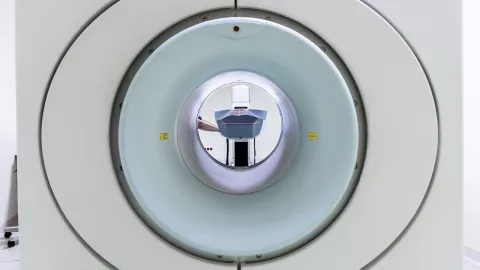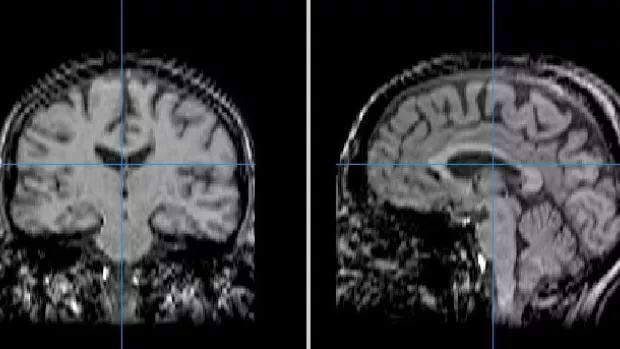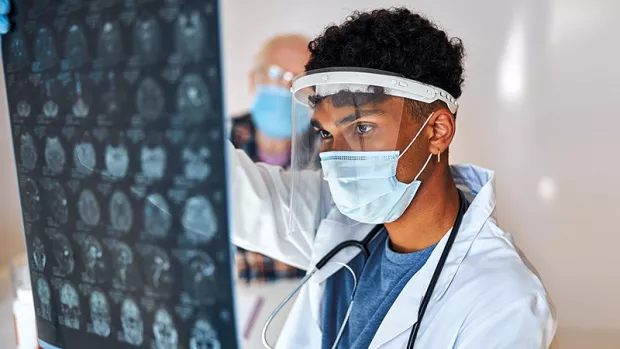
Transforming trials with MRI
MRI technology has been evolving. Techniques are faster and more powerful than ever. And researchers are making the most of this new technology so we can stop MS sooner.
Clinical trials for progressive MS aim to see if a potential treatment can slow or stop disability getting worse. But disability can get worse quite gradually, over many years. So it can a long time to see if a potential treatment is helping.
This can mean researchers spend a long time testing a drug that turns out to be ineffective. But now, MRI technology is helping solve this. MRI scans can give us a window into the brain to see whether new treatments look promising much earlier on, before symptoms of progression even appear.
Testing treatments to repair myelin
Repairing myelin, the protective coating around nerves is a key step in stopping MS. Researchers at our Cambridge Centre of Excellence for Myelin Repair recently used MRI in a small phase 2 trial. It showed, for the first time, that myelin repair in people with MS is possible.
They used a type of MRI scan called magnetisation transfer ratio (MTR). This technique measures changes in the amount of myelin in our brains. It detects a signal that goes down when myelin is damaged, and back up as myelin repairs. So an increase in MTR signal tells us that myelin repair is happening.
By using MTR the team knew the drug, called bexarotene, looked promising early on. Unfortunately some people on the trial had severe side effects, so it isn’t being taken forward as a treatment.
Now, researchers are using MTR in a new myelin repair trial which is currently underway.
Read more about the new myelin repair trial
Testing treatments to protect nerves
Professor Jeremy Chataway and his team also ran a phase 2 trial with the help of MRI. They tested whether a common cholesterol-lowering drug, called simvastatin, could protect nerves from damage and slow disability progression.
They used MRI to look for changes in the brain that measure nerve damage. Like brain atrophy, which is a loss of nerve cells in the brain. This can be seen on MRI many months before there are visible signs of disability worsening. So it can be used to monitor the effect drugs earlier on.
People taking simvastatin in the trial had a slower rate of brain atrophy (nerve cell loss) than people taking a dummy drug. So it could have the potential to protect nerves.
Thanks to these MRI results, we’re supporting a larger phase 3 trial, MS-STAT2, to confirm if simvastatin does slow disability progression. The trial has completed recruitment and we’re expecting results in 2025.
Using MRI to merge two trials into one
These trials have taught us a lot about the potential of MRI. So we used this to design Octopus, a first of its kind mega-trial for progressive MS. With the help of MRI, it could test potential treatments up to three times faster.
Usually MRI results would be analysed at the end of a phase 2 trial to see if a treatment shows promise. If it does, a phase 3 trial with lots more people is needed to confirm the results. But the Octopus team will look at MRI scans part way through the trial, instead of the end. If these early MRI results show potential, they’ll invite hundreds more people to join the trial. This means instead of setting up a separate phase 3 trial, they’ll do one mega-trial. It could save years of time.
And if MRI shows the treatment doesn’t seem to be helping, the team will drop it from the trial and start testing a different one. This will avoid wasting resources and time on a drug that is unlikely to be successful.
Find out more about Octopus and how to register your interest
Future of MRI
There are many ways MRI can help us find treatments to stop everyone’s MS sooner. We’re confident it’ll help Octopus and other trials set the course to revolutionise treatments for progressive MS.




